The Visayan warty pig is critically endangered due to habitat loss, with only a small fraction of its original territory remaining. Specifically, less than 4% of its habitat remains on Negros and fewer than 8% on Panay.
This pig plays a vital role in its ecosystem, aerating soil and supporting biodiversity through its foraging behaviors.
However, hunting and hybridization with domestic pigs further threaten its existence.
Conservation efforts and community engagement are urgently needed to protect this unique species.
Overview of the Visayan Warty Pig
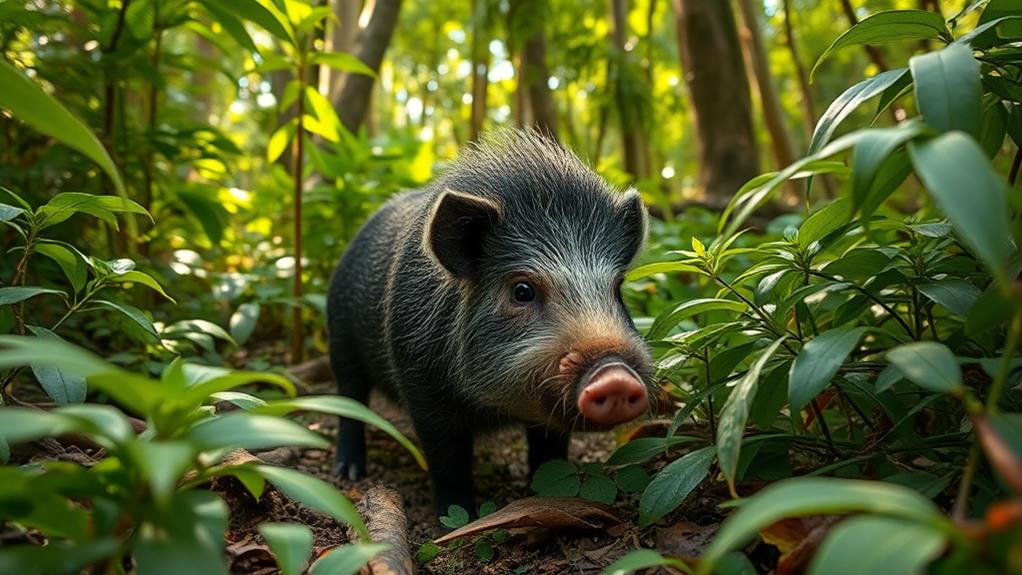
The Visayan Warty Pig: A Critically Endangered Species
The Visayan warty pig, native to the Visayan Islands of the Philippines, is on the brink of extinction due to habitat loss. Found primarily on Negros and Panay, these unique animals are struggling to survive with less than 4% of their original habitat remaining on Negros and less than 8% on Panay.
Characteristics of Visayan Warty Pigs
These pigs are distinctively characterized by three pairs of fleshy facial bumps and a distinctive tuft of hair in males during the breeding season.
They've stocky bodies covered in coarse, dark brown to black fur, weighing between 50 to 90 kg. The average litter size is three piglets, with a 118-day gestation period, indicating a slow reproduction rate.
The Importance of Conservation
Understanding the plight of the Visayan warty pig is crucial. Their loss wouldn't only diminish biodiversity but also disrupt the ecological balance in their native habitats.
Conservation efforts are essential to protect these remarkable creatures and prevent their extinction.
Physical Characteristics
Physical Characteristics of Visayan Warty Pigs
Visayan warty pigs (Sus cebifrons) are distinguished by their unique physical traits. These characteristics not only define their appearance but also play crucial roles in their survival.
Body Size and Coat
Visayan warty pigs typically weigh between 20-80 kg and have dark gray fur with sparse bristly hairs. Males develop a long mane that can appear light brown or silvery, which is a distinct feature of this species.
Defense Mechanisms
Males have three pairs of fleshy warts on their faces, which serve as natural defenses against rival tusks during confrontations. These warts are a unique adaptation that helps them protect themselves from harm.
Species Identification
Visayan warty pigs have a distinctive white stripe over their nose, which is a key characteristic for species identification.
Face Structure and Foraging
Their long faces, ending in round nasal discs, enhance their foraging abilities. This unique face structure allows them to efficiently search for food in their forest habitats.
Piglet Characteristics
Piglets are born with light brown fur and dark stripes, which help them camouflage in forest habitats until they mature. This adaptation is crucial for their survival during the early stages of their life.
Conservation Importance
Understanding these physical characteristics of the Visayan warty pig is crucial for conservation efforts. By recognizing their unique traits, we can appreciate the importance of preserving their habitat and ensuring the survival of this critically endangered species. Furthermore, understanding the physical characteristics of the Visayan warty pig can also help researchers in their efforts to protect other rare bird species in the region. By studying their behaviors and habitat requirements, conservationists can implement targeted measures to create a thriving environment for not only the warty pig, but also for other vulnerable species that share their ecosystem. This knowledge can inform the development of conservation programs and policies that benefit a wide range of endangered animals.
Habitat and Distribution
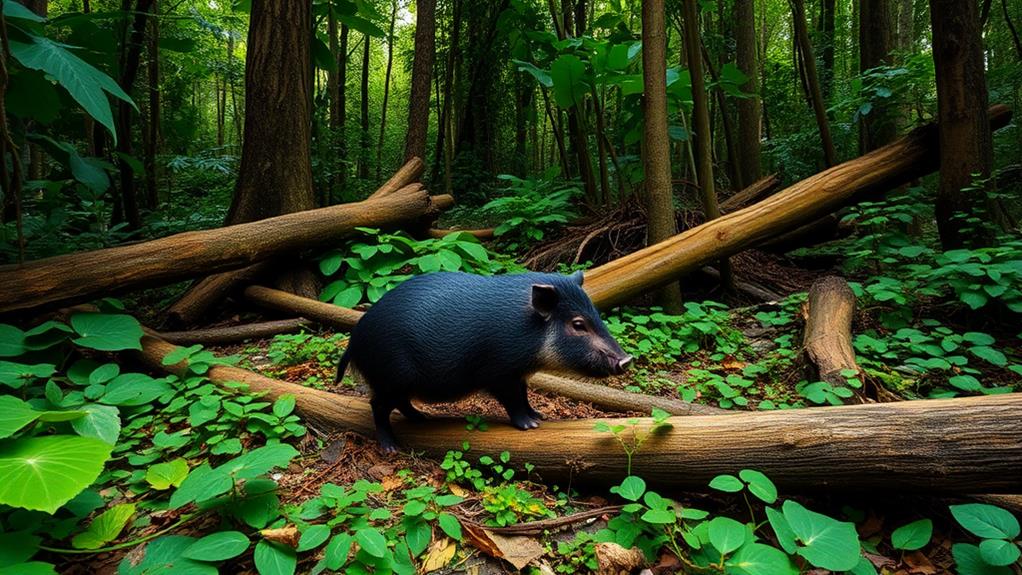
Habitat Loss Threatens the Visayan Warty Pig's Survival
The Visayan warty pig (*Sus cebifrons*) is critically endangered due to drastic habitat loss, which has reduced its range to isolated patches on Negros and Panay islands in the Philippines. Historically, these pigs thrived in tropical and subtropical forests at elevations between 200 to 1,000 meters. However, deforestation and agricultural expansion have destroyed their habitat, leaving less than 4% of their original habitat on Negros.
Fragmented Habitats Limit Movement and Threaten Survival
The Visayan warty pig's population has dwindled to an estimated few hundred individuals due to significant habitat destruction. This has forced them into fragmented areas, limiting their movement and threatening their survival.
Protecting Remaining Habitats is Crucial
Protecting the remaining habitats is essential to prevent extinction. Engaging local communities can foster a collaborative approach to preserving the Visayan warty pig's environment.
Diet and Feeding Behavior
Habitat loss affects the Visayan warty pig's ability to find food, forcing them to adapt their foraging behaviors.
As their natural habitats shrink, these pigs have increasingly turned to cultivated crops, leading to conflicts with local farmers. Their diet primarily consists of roots and tubers, fruits, small invertebrates, fungi, and leaves and grasses.
This omnivorous diet is crucial for their survival. With a strong sense of smell, the Visayan warty pig can effectively locate food in dense forest environments. They typically forage during the day, although they may shift to nocturnal activities based on environmental conditions.
The Visayan warty pig's feeding habits play a significant role in their ecosystem. By aerating the soil and dispersing seeds, they contribute to the health of their habitat. For example, their rooting behavior helps to aerate the soil and disperse seeds, promoting ecosystem health.
However, the ongoing loss of their natural environment jeopardizes their feeding opportunities. If we don't act to protect their habitats, we risk losing not only the Visayan warty pig but also the ecological balance they help maintain.
Reproductive Strategies
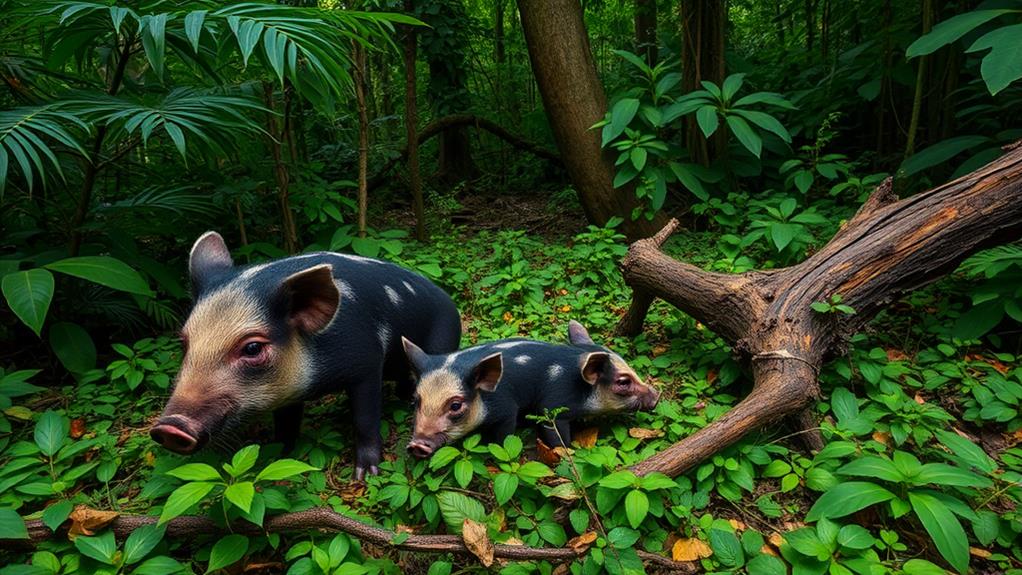
Understanding the Breeding Season
The breeding season of the Visayan warty pig is crucial for their survival, especially given their vulnerable status. Females typically reach sexual maturity between 12 to 14 months in captivity, but it may take 2 to 3 years in the wild. This delayed maturity can significantly impact population recovery, making it vital to ensure their breeding habitats remain protected.
Reproductive Cycle
The gestation period for Visayan warty pigs lasts approximately 118 days, resulting in an average litter size of three piglets, although litters can range from two to four. At birth, piglets are light brown with dark stripes that fade by their first birthday, providing natural camouflage from predators.
Maternal Care and Weaning
Weaning occurs at six months, allowing piglets to transition to solid food while still benefiting from maternal care. Sows exhibit remarkable maternal behaviors, including nest-building, which ensures warmth and safety for their young.
Conservation Implications
Protecting these reproductive strategies is crucial for the Visayan warty pig's future, as habitat loss continues to threaten their existence.
Social Structure and Behavior
The social structure of the Visayan warty pig is crucial for their survival, particularly in the context of their reproductive success. Small family groups enhance their ability to find food and protect their young. Understanding their behavior provides insights into their ecological role and the importance of preserving their habitat.
Family Units: A typical group consists of one adult male, several females, and 3 to 12 offspring. This structure allows for cooperative breeding and resource sharing.
Foraging Patterns: Visayan warty pigs primarily forage during the day, relying on their keen sense of smell to locate various food sources. This adaptation enables them to thrive in their native habitat.
Communication: Vocalizations, such as grunts and snorts, enable coordination and social interaction within the group. These vocal cues facilitate cooperation and warning calls.
Behavioral Adaptability: In captivity, Visayan warty pigs have demonstrated tool use for digging, revealing their intelligence and adaptability. This ability highlights their capacity to adjust to changing environments.
Conservation Imperative: Due to their critically endangered status, much about their wild behavior remains unknown, highlighting the urgency of conservation efforts. Preserving their habitat is crucial for the species' survival.
Understanding the social structure and behavior of the Visayan warty pig is essential for developing effective conservation strategies.
Evolutionary Background
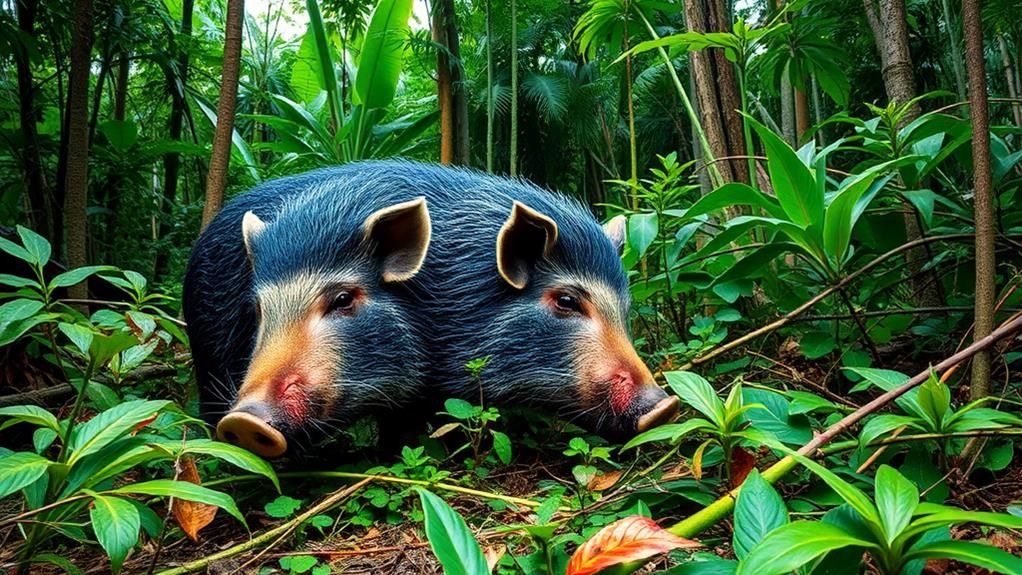
The Visayan warty pig's evolutionary journey spans approximately 12,000 years, shaped by isolation and adaptation. This species diverged from its wild boar ancestors, developing unique physical and behavioral traits that enabled it to thrive in the rainforest habitat across six Philippine islands.
Two recognized subspecies emerged due to genetic isolation: the Cebu warty pig and the Negros warty pig. However, the evolutionary background of the Visayan warty pig is now under threat.
Habitat loss, driven by deforestation and agricultural expansion, has significantly reduced its living space, complicating its survival.
Genomic studies reveal strong selection for unique traits, but interbreeding with domestic pigs introduces additional genetic challenges, diminishing the species' genetic diversity.
This loss of diversity impacts their adaptability and jeopardizes conservation efforts aimed at preserving this critically endangered species.
Understanding the Visayan warty pig's evolutionary history is crucial, as it highlights the urgent need for targeted conservation strategies to mitigate the effects of habitat loss and ensure its survival.
Conservation Status
The Visayan warty pig (*Sus cebifrons*) is critically endangered, with a dwindling wild population of around 300 individuals in captivity.
Habitat loss, primarily driven by deforestation, has ravaged their environment, leaving less than 4% of their original range on Negros and under 8% on Panay.
The species faces significant challenges, including:
A drastic decline: The Visayan warty pig has likely gone extinct on four of the six islands it once inhabited. This decline is a result of habitat destruction and hunting pressures.
Limited habitat: Only small, fragmented areas remain viable for the species' survival. For instance, the remaining forests on Negros and Panay are fragmented and degraded, making it difficult for the pigs to roam and find food.
Urgent conservation needs: Immediate action is vital to prevent further decline. Conservation efforts must focus on preserving the remaining habitats and engaging local communities to reduce hunting pressures.
Community involvement: Engaging local populations can help reduce hunting pressures. By educating local communities about the importance of conservation, they can become allies in protecting the Visayan warty pig.
Captive breeding programs: These programs are essential for maintaining genetic diversity and population stability. Breeding programs in captivity can help increase the population and eventually reintroduce the pigs into the wild.
Without robust conservation measures focusing on habitat preservation and community engagement, the Visayan warty pig's fate hangs in the balance.
Threats to Survival

Habitat loss is a critical threat to the Visayan warty pig's survival. The species' natural environment is rapidly shrinking, with less than 4% of its habitat remaining on Negros and less than 8% on Panay. This is primarily due to deforestation and agricultural expansion, which significantly diminish the pigs' chances of survival.
Hybridization with domestic pigs poses a severe genetic threat. Interbreeding risks the loss of unique traits that define the Visayan warty pig, compromising its genetic integrity. This threat is particularly concerning, as it could lead to the loss of the species' distinct characteristics.
Hunting for bush meat continues to plague the population. Despite government efforts to impose penalties, hunting remains a significant threat to the Visayan warty pig's survival.
The ongoing issue contributes to the alarming decline in numbers.
Misconceptions about the Visayan warty pig's role in the ecosystem exacerbate its plight. Human-wild pig conflicts resulting from these misunderstandings lead to unnecessary killings.
The combination of habitat destruction, hunting, and disease transmission from domestic pigs has resulted in a staggering 95% loss of the Visayan warty pig's former range.
Urgent action is needed to address these threats. If left unaddressed, the Visayan warty pig's survival will remain critically endangered.
Conservation Efforts
Conservation Efforts for the Visayan Warty Pig
The Visayan warty pig is threatened by habitat loss and hunting, prompting various conservation initiatives to protect its survival. These efforts focus on preserving habitats, ensuring legal safeguards, and promoting coexistence with local communities.
Habitat Protection
Efforts are underway to safeguard existing habitats and prevent further destruction. This involves maintaining the integrity of forest ecosystems, which are essential for the pig's survival.
Legal Safeguards
The Philippine Wildlife Act provides legal frameworks to mitigate threats from hunting and habitat degradation. This law prohibits the hunting and trade of the Visayan warty pig, and penalizes those who violate it.
Captive Breeding Programs
Captive breeding programs aim to create an insurance population for potential reintroduction into the wild. Currently, around 300 individuals are being bred in captivity to increase the population and reduce the risk of extinction.
Surveys for Rewilding
Surveys in national parks on Panay and Negros identify suitable habitats where pigs can be reintroduced or populations strengthened. These surveys help conservationists determine the best areas for reintroduction, ensuring the pigs' survival in the wild.
Community Engagement
Local farmers often kill warty pigs due to crop raiding, making awareness programs critical for promoting coexistence. Education and outreach programs inform farmers about the importance of coexisting with the pigs and provide them with alternative crop protection methods.
These conservation efforts are crucial for protecting the Visayan warty pig and promoting community understanding of its ecological role.
Supporting these initiatives can help ensure the species' survival.
Role in Ecosystem

Visayan Warty Pigs: Ecological Contributors
Visayan warty pigs play a vital role in their ecosystems, influencing plant and animal populations through their foraging behaviors. Their rooting activities aerate the soil, enhancing forest health and promoting plant growth. For example, their digging helps to break up compacted soil, allowing air and water to penetrate, which benefits plant roots.
As omnivorous foragers, they consume fruits, leaves, and earthworms, maintaining a balance within their habitat's plant and animal populations. This is crucial because it ensures that no single species dominates the ecosystem.
Visayan warty pigs are essential for seed dispersal. They eat fallen fruits and excrete seeds, supporting forest regeneration and biodiversity. This process is vital for the survival of many plant species that rely on the pigs to spread their seeds.
However, habitat loss threatens the pigs' ecological role. As their natural environments diminish, their ability to aerate soil and contribute to plant diversity declines, leading to unstable ecosystems.
Conflicts with farmers can arise, as the pigs' foraging can be seen as a threat to agricultural crops.
The social structure of family groups is crucial for maintaining genetic diversity and resilience within the population. This is vital for ecosystem stability, as it ensures that the pig population remains healthy and adaptable.
Protecting the Visayan warty pig is essential for preserving ecosystem balance, as they play a unique role in maintaining the delicate balance of their ecosystems.
Importance of Public Awareness
Raising public awareness about the Visayan warty pig is crucial for its survival and the health of its ecosystem. Understanding the significance of this critically endangered species can help combat the threats it faces.
Highlighting its Endangered Status: Initiatives like National Geographic's Photo Ark elevate the profile of the Visayan warty pig, emphasizing its plight. This project documents endangered species through photography, increasing global awareness and sympathy.
Shifting Perceptions: Education campaigns focus on younger generations, helping them see wild pigs as vital ecological players rather than just food sources.
For example, educational programs in rural areas teach children about the pig's role in seed dispersal and forest regeneration.
Reducing Poaching: Increased visibility through media can discourage poaching and habitat destruction, both of which severely threaten this species.
Documentaries and news articles highlighting the consequences of poaching can raise public empathy and encourage responsible behavior.
Engaging Communities: Involving local farmers in conservation efforts helps foster coexistence, reducing instances of pigs being killed for crop raiding.
Conservation organizations work with farmers to develop sustainable farming practices and provide compensation for crop damage.
Funding Awareness: Public programs can highlight the need for ongoing conservation funding, ensuring resources are available to protect remaining populations.
Governments and organizations can allocate funds for habitat preservation, research, and community engagement initiatives.
Captive Breeding Programs
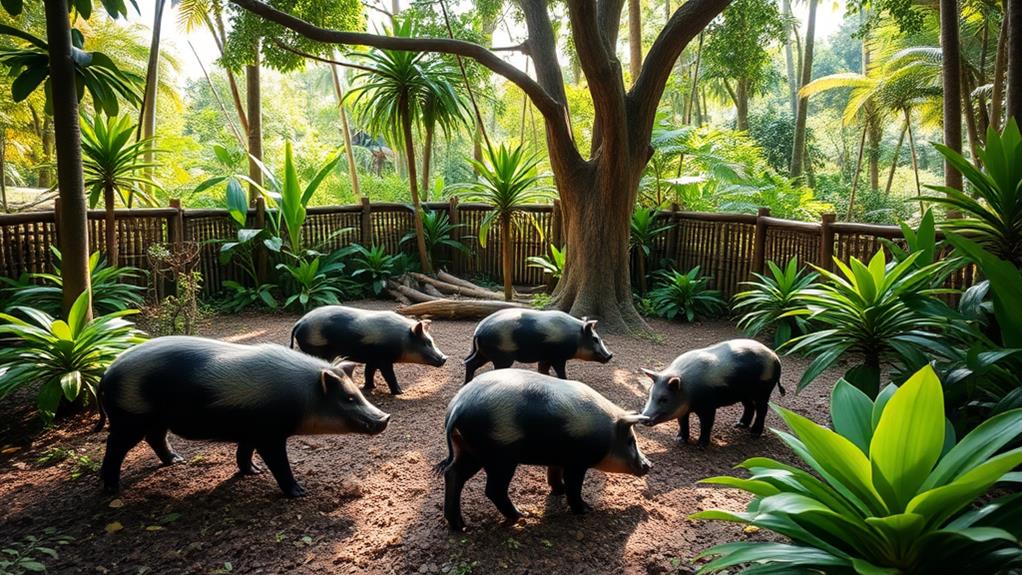
Captive Breeding Programs: A Lifeline for the Visayan Warty Pig
Captive breeding programs are crucial for the survival of the critically endangered Visayan warty pig. With only around 300 individuals in captivity worldwide, these initiatives focus on maintaining a genetically diverse population. By pairing genetically distinct individuals, the risk of inbreeding is minimized, ensuring the survival of the subspecies.
| Key Aspects | Details |
|---|---|
| Collaboration | Breeding programs involve zoos, conservation organizations, and local communities for effective management. |
| Reintroduction | Successful breeding opens doors for reintroducing pigs into their natural habitats, monitored in national parks on Panay and Negros. |
| Community Engagement | Education campaigns raise awareness about the importance of the Visayan warty pig, helping to reduce hunting pressures. |
The Importance of Captive Breeding Programs
These programs are essential not just for the pigs' survival but also for fostering community involvement. By informing local populations about the ecological significance of the Visayan warty pig, we can cultivate a sense of stewardship. Investing in these programs is not just an act of conservation; it's a commitment to preserving biodiversity and our natural heritage.
Future of the Visayan Warty Pig
The Visayan warty pig's survival depends on a multifaceted approach that combines conservation efforts and community involvement. With only around 300 individuals remaining in captivity and severe habitat loss reducing their range, immediate action is necessary.
Captive breeding programs are crucial to enhance genetic diversity, which is essential for the species' long-term survival. These programs allow for the exchange of genetic material between individuals, reducing inbreeding and increasing the chances of healthy offspring.
Local community engagement is vital to ensure the success of conservation efforts. Educating local communities about the importance of warty pigs and promoting sustainable farming practices can reduce habitat destruction and human-warty pig conflicts.
For instance, teaching farmers about the benefits of agroforestry can help reduce deforestation and provide alternative income sources.
Habitat restoration is essential to expand the Visayan warty pig's natural range. Restoring deforested areas can provide a safe habitat for the species, allowing them to thrive and increase in numbers.
Advocating for habitat restoration efforts and supporting organizations that work on reforestation can make a significant impact.
Hybridization with domestic pigs is a major threat to the Visayan warty pig's survival. Raising awareness about the risks of hybridization is crucial to prevent the loss of genetic purity.
This can be achieved by educating local communities and promoting the importance of keeping domestic pigs separate from warty pigs.
Conservation funding is critical to support ongoing initiatives and research. Donating to reputable organizations that work on Visayan warty pig conservation can provide the necessary resources to implement effective conservation strategies.
Questions and Answers
What Caused Cebu Wart Pig's Extinction?
Habitat destruction was the primary cause of the Cebu warty pig's extinction. The species lost 95% of its original range due to clearance for agriculture and logging, leaving it without a suitable habitat.
This destruction of its natural environment made it impossible for the pig to thrive.
Overhunting and perception as pests further threatened the species. The Cebu warty pig was hunted for its meat, and it was also viewed as a pest, leading to a significant decline in its population.
Genetic contamination from domestic pigs was another major factor. The interbreeding of domestic pigs with the Cebu warty pig diluted its gene pool, compounding the crisis and pushing the species towards extinction.
Understanding these factors is crucial to preventing similar fates for other species.
What Main Thing Has Depleted the Visayan Pigs Habitat?
Deforestation has depleted the Visayan pig's habitat. This is primarily due to the expansion of agriculture and logging, which leads to habitat fragmentation.
As a result, Visayan pig populations become isolated, limiting their access to food and mates. For example, when forests are cleared for farming or timber, the pigs are left with smaller, disconnected areas to live in, making it harder for them to find food and potential partners.
This loss of forest cover not only reduces the pigs' living space but also disrupts the delicate ecosystem they depend on.
How Can We Save the Visayan Warty Pig?
Habitat restoration is crucial to save the Visayan warty pig. Establishing protected areas and engaging local communities can significantly reduce hunting pressures and promote coexistence.
For instance, the Philippine government has established several protected areas, including the Northwest Panay Peninsula Natural Park, which provides a safe habitat for the Visayan warty pig.
Captive breeding programs are essential to maintain genetic diversity. These programs help increase the population of the Visayan warty pig and reduce the risk of inbreeding.
The Philippine Crocodile Rescue and Conservation Center, for example, has a captive breeding program for the Visayan warty pig.
Raising awareness and education are vital to shift public perception. Educational initiatives can foster broader support for projects that aim to restore their habitats and ensure the species' survival.
Local schools and communities can be involved in awareness campaigns, teaching the importance of conservation and the unique characteristics of the Visayan warty pig.
What Is the Most Endangered Pig in the World?
The most endangered pig in the world is the Visayan warty pig.
This species is critically endangered, with only about 300 individuals left. Their survival depends on conservation efforts, particularly habitat restoration initiatives.
By supporting these projects, individuals can significantly improve the Visayan warty pig's chances of survival.
Raising awareness and contributing to recovery projects is crucial in preventing the extinction of this unique species.